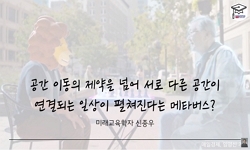As science and technology develop and the realm of culture expands, new cultural identities emerge. With the pursuit of multiculturalism, the importance of each country's cultural identity increases, as it is reflected in how each nation deals with th...
http://chineseinput.net/에서 pinyin(병음)방식으로 중국어를 변환할 수 있습니다.
변환된 중국어를 복사하여 사용하시면 됩니다.
- 中文 을 입력하시려면 zhongwen을 입력하시고 space를누르시면됩니다.
- 北京 을 입력하시려면 beijing을 입력하시고 space를 누르시면 됩니다.
한나라 미술의 재해석을 통한 공생사상 표현 연구 : -본인 작품을 중심으로- = A Study of the Expression of Symbiosis Thought through the Reinterpretation of Han Dynasty Fine Arts - Focused on Researcher's Work
한글로보기https://www.riss.kr/link?id=T17058184
- 저자
-
발행사항
대전 : 목원대학교 대학원, 2024
- 학위논문사항
-
발행연도
2024
-
작성언어
한국어
-
주제어
공생사상 ; 한나라 미술 ; 공간 ; 재해석 ; Symbiosis Thought ; Han Dynasty art ; The same space ; Reinterpretation
-
발행국(도시)
대전
-
형태사항
viii, 125 ; 26 cm
-
일반주기명
지도교수: 한창규
-
UCI식별코드
I804:25006-200000815650
- 소장기관
-
0
상세조회 -
0
다운로드
부가정보
다국어 초록 (Multilingual Abstract)
As science and technology develop and the realm of culture expands, new cultural identities emerge. With the pursuit of multiculturalism, the importance of each country's cultural identity increases, as it is reflected in how each nation deals with their own culture. Therefore, establishing a new form of aesthetics by combining traditional aesthetics with new ideologies and forms to meet the demands of the times is crucial. Consequently, the researcher has chosen the theme of symbiotic expression through the reinterpretation of the art of the Han Dynasty. The reason for choosing this theme is to establish a new relationship between traditional culture and contemporary creation through the artistic expression of cross-media, to demonstrate the relevance of the concept of modern art and traditional Chinese philosophy, to explore the universal values of Chinese national philosophy in modern times, and to recognize its cultural contribution. By extensively applying and promoting the traditional art of Han Dynasty, it is possible to promote and optimize the complementary relationship between the ethical perspective of traditional culture and the modern values. Therefore, this research can be considered a very meaningful endeavor.
The main focus of this study is how the excellent artistic traditions of the Han Dynasty are closely connected and mutually beneficial with contemporary art. Using this as a starting point, the researcher conducted theoretical exploration based on Kisho Kurokawa's concept of symbiosis proposed in 1980, as well as the idea of symbiosis in traditional Chinese philosophy. The study found that when the concept of "symbiosis" is applied as a methodological perspective in cultural studies, it emphasizes the relationship or form of mutual dependence and influence between two interdependent and interacting systems or entities. In this article, the symbiotic perspective places the inheritance of traditional Han Dynasty art and contemporary art on opposite sides of the same system, as a way to contemplate the relationship between tradition and contemporary art and the tendency upheld in artistic practices, emphasizing coexistence in time. Between Han Dynasty art and contemporary art, "symbiosis" implies the coexistence of different civilizations, cultures, and technologies in the same space, representing the interaction and interplay between different forms of art, creating new artistic forms and values through fusion and cross-innovation.
In the theoretical context of traditional and contemporary symbiosis, the researcher examined contemporary artist Xu Bing's modern representation and transformation of traditional ethnic symbols, demonstrating the coexistence of tradition and modern forms in his anti-traditional artistic expression. The study also examined the work of South Korean artist Kim Hwan-gi, whose monochrome abstract paintings combine traditional elements with abstraction, employing a technique of repetitive cycles. The examination of Carl Andre mainly focused on the artistic expression of his works: the overlapping structures of visibility and invisibility, as well as the interaction and symbiosis between materials and spatial environments. Based on this foundation, the works of these three pioneering artists were compared with those of the researcher, analyzing the similarities and differences in creative concepts and formal expressions.
The researcher's works establish connections through the combination of Han Dynasty image symbols and material media, employing techniques of reconstruction and appropriation to express the coexistence of Han Dynasty art elements and contemporary art in synchrony. In the creative process, Han Dynasty art is conceived as visual elements in space, emphasized through the use of materials such as cloth, wood, and modern formal language, highlighting both traditional and contemporary aspects to achieve a spirit of pluralistic symbiosis. Symbiosis does not imply uniformity but rather diversity. Ultimately, the works present these Han Dynasty image symbols in a new artistic language through the arrangement of structures and groups and the utilization of contemporary technology, showcasing the enduring spirit of Han Dynasty art and aesthetic consciousness of life and nature. The works encompass the depth of culture, the power of technology, and the warmth of art, while also offering the public reflections on history and contemplation. The expression of ethnicity is not the meaning of the works; rather, the representation behind the images is the true intention of the creation.
This study combines theoretical research with practical creation, breaking the spatial and temporal restrictions of traditional Han Dynasty art and integrating it with society, environment, and technology, thus proposing new paths for future artistic exploration and social engagement. The visual elements and aesthetic concepts of Han Dynasty art engage in dialogue and integration with contemporary art creation, not only innovating and revitalizing traditional art but also expanding the language and expression of contemporary art. The creative process involves the researcher's expression of the creation, transformation, and contemporary application of "Han Dynasty image symbols," involving deep reflections on the composition, cultural significance, and the relationship between symbols and nature. Additionally, through the works, the study contemplates the symbiosis between history and culture, tradition and contemporaneity, the East and the West, as well as between media and reality.
국문 초록 (Abstract)
과학기술이 발달하고 문화의 영역이 확장됨에 따라 새로운 문화 정체성이 나타나게 된다. 서로 다른 문화의 공생을 추구하는 다문화주의로 인해, 각국의 문화 정체성 중요성이 높아지게 되...
과학기술이 발달하고 문화의 영역이 확장됨에 따라 새로운 문화 정체성이 나타나게 된다. 서로 다른 문화의 공생을 추구하는 다문화주의로 인해, 각국의 문화 정체성 중요성이 높아지게 되는데 여기에서 문화 정체성의 중요성은 자국의 문화에 대처하는 방향으로 나타난다. 따라서 전통 미학을 새로운 시대와 이념 그리고 새로운 형식과 결합하여 새로운 미학 형태를 확립하는 것은 시대적 요구이라고 할 수 있다. 연구자는 이에 영향을 받아 ‘한나라 미술의 재해석을 통한 공생사상 표현 연구’라는 주제를 정하였다. 이러한 주제를 선택한 이유는 크로스 미디어라는 예술적 표현 방식을 통해 전통문화와 현대적 창작 간에 새로운 관계를 정립하여 현대 미술의 관념과 중국 전통사상의 연관성을 보여주고, 한나라 시대의 문화 사상이 현대에서 갖는 보편적 가치를 발굴하며 그 문화적 기여를 인정하기 위함이다. 한나라의 전통미술을 광범위하게 응용하고 보급함으로써 전통문화의 윤리관과 현대적 가치의 상호보완을 촉진하고 최적화할 수 있다. 따라서 본 연구는 매우 의미 있는 작업이라 할 수 있다.
본 연구는 중국 한나라(中國漢代)의 미술 자원이 어떻게 현재와 밀접하게 연결되고 상호 소통하여 공생할 수 있었는지에 관한 연구이다. 연구자는 구로카와 기쇼(Kisho Kurokawa)가 1980년에 제안한 공생사상과 중국 전통 철학의 공생 이념에 근거하여 연구를 진행하였다. 연구에 따르면 상호보완적인 발전을 강조하는 방법론적 관점인 ‘공생사상’은 문화 연구 분야에서 상호 의존하며 상호 영향을 미치는 시스템 및 사물간의 관계 혹은 형태를 강조하는 데 사용된다. 본 연구는 공생의 관점에서 한나라 전통 미술의 계승과 현대예술을 동일한 시스템의 양측에 두고 전통과 현대 양자의 관계, 예술 창작이 나아가고자 하는 방향을 사고함으로써 공존을 강조하였다. ‘공생’은 같은 공간의 서로 다른 문명, 문화, 과학 기술이 함께 어울리고 예술 형식 간의 상호작용이 이루어진 것으로, 융합과 혁신을 통해 새로운 예술 형식과 가치를 만들어낸다.
연구자는 전통과 현대의 공생이라는 이론적 배경에서 구조주의, 해체주의, 기호학 등의 이론을 참고하여 현대미술가 서빙(徐冰)의 전통 기호에 관한 현대적 표현과 전환 방식, 반(反)전통적 예술 표현에서 전통과 현대적 표현의 공생을 연구하였다. 또한 한국의 예술가인 김환기를 연구하였다. 김환기의 단색 추상화는 전통 요소와 추상 예술의 상호 결합으로 반복 및 순환의 형식을 통해 완성되었다. 칼 안드레(Carl Andre)에 대한 연구는 주로 작품의 예술적 표현 형식에서 비롯되었다. 즉, 가시성과 비가시성의 중첩 구조, 재료와 공간 및 환경의 융합 방면에서 진행되었다. 상기 내용을 토대로 세 명의 선행작가 작품과 연구자의 작품을 비교하였고, 창작이념과 형식 표현에서 세 선행작가와 연구자 본인 작품의 공통점과 차이점을 분석하였다.
연구자의 작품은 한나라 시대의 이미지 속 기호와 물질적 매개체의 결합을 보여주었으며, 재구성 및 차용의 창작 방식을 통해 한나라 시대의 미술 요소와 현대 예술의 공존을 표현하였다. 연구자는 창작 과정에서 한나라 미술을 공간의 시각적 요소로 설정하고 천, 나무 등 물질적 재료와 현대적 형식의 조합을 통해 전통과 현대 두 측면을 강조하여 다원적 공생의 정신에 이르렀다. 공생은 ‘화이상동(和而相同)’이 아니라 오히려 ‘화이부동(和而不同)’에 가깝다. 결론적으로 연구자의 작품은 쌓고, 나열하고, 겹겹으로 포개는 구조 배치 방식과 현대 기술의 도움을 받아 한나라 시대의 이미지 기호를 새로운 유형의 예술 스타일로 나타내어, ‘생생불식’(生生不息)의 한나라 예술 정신과 생명, 자연에 대한 미적 의식을 보여주었다. 또한 연구자의 작품은 문화적 깊이, 과학 기술의 힘, 예술의 온도를 담고 있으며 동시에 대중에게 역사를 되돌아보고 깊이 성찰할 수 있는 기회를 제공하였다. 창작의 의미는 민족적 정서를 표현하는 데 있는 것이 아니라 이미지 뒤에 감춰진 상징적 의미를 알아내도록 하는 데 있다.
본 연구는 이론적 연구와 실천적 창작을 결합한 방식을 통하여 한나라 전통 예술이 시공간의 제약에서 벗어나 사회, 환경, 그리고 기술과 융합하도록 하였다. 이로써 미래의 예술적 탐구에 새로운 길을 제시하였다. 한나라 미술의 시각적 요소 및 미적 관념과 현대 예술 창작의 융합은 전통예술의 혁신이며 나아가 현대예술의 언어와 표현 방식의 확장이다. 본 연구자의 창작은 ‘한나라 이미지 기호’의 창조, 현대적 응용과 전환에 대한 연구자의 표현으로 기호와 관련한 구성 형태, 기호와 문화, 기호와 자연 간의 심층적인 사고와 관련이 있다. 동시에 연구자는 작품을 통해 역사와 문화, 전통과 현대, 동양과 서양, 그리고 이상과 현실 간의 공생을 연구하였다.
목차 (Table of Contents)
- 국문초록 ⅰ
- 표 목차 ⅵ
- 그림 목차 ⅶ
- 제1장 서론 1
- 국문초록 ⅰ
- 표 목차 ⅵ
- 그림 목차 ⅶ
- 제1장 서론 1
- 제1절 연구배경 및 연구목적 1
- 제2절 연구범위와 연구내용 6
- 제2장 본론 9
- 제1절 공생사상에 대한 이론적 고찰 9
- 1. 공생 관련 이론 배경 9
- 1) 공생의 개념 9
- 2) 구로카와 기쇼(Kisho Kurokawa)의 공생 사상 11
- 3) 중국 전통 철학에서의 공생이념 13
- 2. 한나라 미술의 특징 17
- 1) 화상석(畵像石) 예술 18
- 2) 한나라의 와당(瓦當) 패턴 21
- 제2절 한나라 미술의 현대적 재해석 24
- 1. 전통 이미지와 현대 매체의 결합 25
- 2. 한나라 예술 정신의 현대적 전환 27
- 제3절 선행작가 작품분석 29
- 1. 서빙(徐冰): 전통 기호의 현대적 표현 29
- 2. 김환기: 전통 요소와 추상 예술의 상호 결합 41
- 3. 칼 안드레(Carl Andre): 비가시성의 중첩 구조 50
- 4. 선행 작가와 연구자 작품 비교 59
- 제4절 연구자 작품 분석 66
- 1. 작품 창작 배경 67
- 2. 내용 분석 69
- 1) 추상과 상징의 공생사상 69
- 2) 다중서사의 공존 77
- 3) 불로장생(长生不老)의 염원 81
- 4) 생생불식(生生不息)의 정신 90
- 3. 창작 방식 분석 102
- 1) 대칭과 질서의 형상 조합 102
- 2) 전통 이미지의 차용과 재구성 105
- 3) 반복과 순환을 통한 공간 표현 107
- 제3장 결론 110
- 참고문헌 113
- Abstract 121












